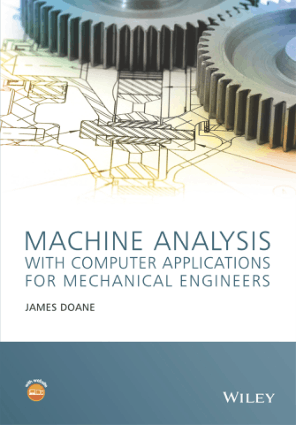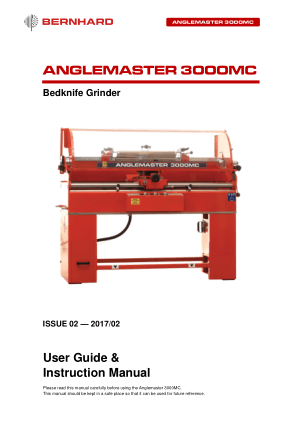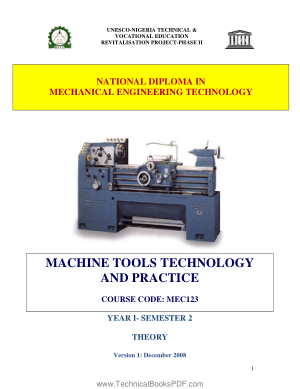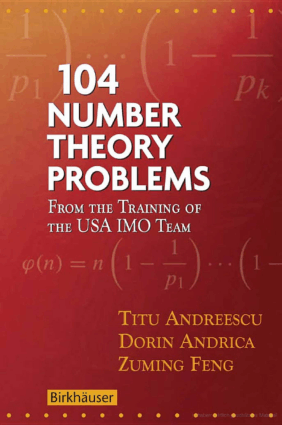Machine Analysis with Computer Applications for Mechanical Engineers by James Doane

| Machine Design , Number Theory | |
| Language | English |
| File Type | |
| 555 | |
| Views | 2,429 views |
| File Size & Downloads | Size 19.7 MiB Downloads 1220 |
Short Desciption:
This "Machine Analysis with Computer Applications for Mechanical Engineers by James Doane" book is available in PDF Formate. Downlod free this book, Learn from this free book and enhance your skills ...
Contents
Preface xv
Acknowledgments xvii
About the companion website xix
1 Introductory Concepts 1
1.1 Introduction to Machines 1
1.1.1 Brief History of Machines 1
1.1.2 Why Study Machine Analysis? 5
1.1.3 Differences between Machine Analysis and Machine Design 6
1.2 Units 6
1.2.1 Importance of Units 6
1.2.2 Unit Systems 6
1.2.3 Units of Angular Motion 8
1.2.4 Force and Mass 8
1.3 Machines and Mechanisms 10
1.3.1 Machine versus Mechanism 10
1.3.2 Simple Machines 10
1.3.3 Static Machine Analysis 11
1.3.4 Other Types of Machines 14
1.4 Linkage Mechanisms 14
1.4.1 Introduction to Linkage Mechanisms 14
1.4.2 Types of Links 14
1.4.3 Types of Joints 15
1.5 Common Types of Linkage Mechanisms 16
1.5.1 Crank–Rocker Mechanisms 17
1.5.2 Slider–Crank Mechanisms 17
1.5.3 Toggle Mechanisms 18
1.5.4 Quick Return Mechanisms 19
1.5.5 Straight Line Mechanisms 19
1.5.6 Scotch Yoke Mechanism 20
1.6 Gears 21
1.6.1 Introduction to Gears 21
1.6.2 Spur Gears 22
1.6.3 Helical Gears 23
1.6.4 Bevel Gears 24
1.6.5 Worm Gears 26
1.7 Cams 27
1.7.1 Introduction to Cams 27
1.7.2 Disk Cams 27
1.7.3 Cylindrical Cams 28
1.8 Solution Methods 28
1.8.1 Graphical Techniques 29
1.8.2 Analytical Methods 29
1.8.3 Computer Solutions 29
1.9 Methods of Problem Solving 30
1.9.1 Step 1: Carefully Read the Problem Statement 30
1.9.2 Step 2: Plan Your Solution 30
1.9.3 Step 3: Solve the Problem 30
1.9.4 Step 4: Read the Problem Statement Again 30
1.10 Review and Summary 31
Problems 31
Further Reading 33
2 Essential Kinematics Concepts 34
2.1 Introdction 34
2.2 Basic Concepts of Velocity and Acceleration 35
2.3 Translational Motion 35
2.4 Rotation about a Fixed Axis 36
2.4.1 Velocity 36
2.4.2 Acceleration 38
2.5 General Plane Motion 41
2.5.1 Introduction 41
2.5.2 Velocity Difference and Relative Velocity 41
2.5.3 Relative Acceleration 47
2.5.4 Instant Center of Rotation 51
2.6 Computer Methods 53
2.6.1 Numerical Differentiation 53
2.6.2 Illustrative Example 54
2.7 Review and Summary 58
Problems 58
Further Reading 65
3 Linkage Position Analysis 66
3.1 Introduction 66
3.2 Mobility 67
3.2.1 Rigid Body Degrees of Freedom 67
3.2.2 Joint Mobility 67
3.2.3 Determining Mobility of a Planar Linkage Mechanism 69
3.3 Inversion 72
3.4 Grashof’s Criterion 72
3.4.1 Introduction 72
3.4.2 Grashof Linkage 73
3.4.3 Non-Grashof Linkage 73
3.4.4 Special Case Grashof Linkage 73
3.5 Coupler Curves 74
3.5.1 Basic Concepts of Coupler Curves 74
3.5.2 Double Points 74
3.5.3 Hrones and Nelson Atlas 75
3.6 Cognate Linkages 76
3.6.1 The Roberts–Chebyshev Theorem 76
3.6.2 Steps for Determining Cognates 76
3.6.3 Cognates for Binary Link 78
3.6.4 Cognates for Slider–Crank Mechanism 79
3.7 Transmission Angle 79
3.8 Geometrical Method of Position Analysis 80
3.8.1 Essential Mathematics 80
3.8.2 Common Approaches for Four-Bar Mechanisms 80
3.9 Analytical Position Analysis 92
3.9.1 Loop Closure Equation 92
3.9.2 Complex Number Notation 98
3.10 Toggle Positions 100
3.11 Computer Methods for Position Analysis 100
3.11.1 Position Analysis Using Spreadsheets 100
3.11.2 Distance Formula to Solve for Output Angle 101
3.11.3 Computer Solutions Using MATLAB and MathCAD 102
3.12 Review and Summary 103
Problems 103
Further Reading 107
4 Linkage Velocity and Acceleration Analysis 108
4.1 Introduction 108
4.2 Finite Displacement: Approximate Velocity Analysis 109
4.3 Instantaneous Centers of Rotation 111
4.3.1 Number of Instant Centers 111
4.3.2 Primary Instant Centers 112
4.3.3 Kennedy–Aronhold Theorem 112
4.3.4 Locating Instant Centers for Typical Four-Bar Mechanisms 112
4.3.5 Locating Instant Centers for Slider–Crank Mechanisms 114
4.3.6 Locating Instant Centers for Other Mechanisms 114
4.3.7 Velocity Analysis Using Instant Centers 115
4.4 Graphical Velocity Analysis 119
4.4.1 Basic Concepts 119
4.4.2 Component Method 122
4.4.3 Parameter Studies 124
4.5 Analytical Velocity Analysis Methods 125
4.5.1 Introduction 125
4.5.2 Vector Method 126
4.5.3 Loop-Closure Method 127
4.5.4 Differentiation of Position Coordinate Equation 129
4.6 Graphical Acceleration Analysis Methods 130
4.7 Analytical Acceleration Analysis Methods 134
4.8 Kinematic Analysis of Linkage Mechanisms with Moving Slides 135
4.8.1 Sliding Motion 135
4.8.2 Motion Relative to Rotating Axes 138
4.8.3 Coriolis Component 141
4.8.4 Geneva Mechanisms 144
4.9 Review and Summary 147
Problems 147
Further Reading 153
5 Linkage Synthesis 154
5.1 Introduction 154
5.1.1 Synthesis Classifications 154
5.1.2 Essential Engineering Geometry and Drafting 155
5.2 Synthesis 155
5.2.1 Type Synthesis 155
5.2.2 Number Synthesis 156
5.2.3 Dimensional Synthesis 156
5.3 Two-Position Graphical Dimensional Synthesis 156
5.3.1 Introduction 156
5.3.2 Using Rocker Motion from a Double Rocker Mechanism 157
5.3.3 Using Rocker Motion from a Crank–Rocker Mechanism 158
5.3.4 Using Coupler Motion 160
5.3.5 Adding a Driver Dyad 161
5.4 Three-Position Graphical Dimensional Synthesis 162
5.4.1 Using Coupler Motion 162
5.4.2 Fixed Pivot Point Locations Defined 163
5.5 Approximate Dwell Linkage Mechanisms 167
5.6 Quick Return Mechanisms 169
5.6.1 Time Ratio 169
5.6.2 Quick Return Crank–Rocker Mechanism 170
5.6.3 Whitworth Mechanism 172
5.6.4 Offset Slider–Crank Mechanism 174
5.7 Function Generation 176
5.7.1 Introduction 176
5.7.2 Accuracy Points 176
5.7.3 Chebyshev Spacing 177
5.7.4 Freudenstein’s Equation: Four-Bar Linkage 178
5.7.5 Error Analysis for Function Generation 182
5.8 Review and Summary 182
Problems 182
Further Reading 189
6 Computational Methods for Linkage Mechanism Kinematics 190
6.1 Introduction 190
6.2 Matrix Review 190
6.2.1 Introduction 190
6.2.2 Matrix Notation 191
6.2.3 Matrix Operations 191
6.2.4 Representing Simultaneous Equations in Matrix Form 193
6.3 Position Equations 196
6.3.1 Introduction 196
6.3.2 Iterative Solution Method 196
6.3.3 MATLAB Program Module for Calculating θ3 and θ4 201
6.3.4 Position Analysis Using MathCAD 202
6.3.5 Linkage Center of Mass Locations 205
6.4 Velocity Analysis 206
6.4.1 Numerical Differentiation 206
6.4.2 Derivatives of Data Containing Errors or Noise 206
6.4.3 Velocity Analysis in MathCAD 207
6.5 Acceleration Equations 209
6.5.1 Numerical Differentiation 209
6.5.2 Acceleration Analysis in MathCAD 209
6.6 Dynamic Simulation Using Autodesk Inventor 210
6.6.1 Basic Concepts 210
6.6.2 Kinematic Constraints 211
6.6.3 Kinematic Analysis Example 211
6.7 Review and Summary 211
Problems 212
Further Reading 214
7 Gear Analysis 215
7.1 Introduction 215
7.2 Involute Curves 216
7.2.1 Conjugate Profiles 216
7.2.2 Properties of Involute Curves 217
7.3 Terminology 219
7.3.1 Pitch Circle and Pressure Angle 219
7.3.2 Base Circle 220
7.3.3 General Gear Tooth Terminology 221
7.3.4 Clearance and Backlash 227
7.4 Tooth Contact 228
7.4.1 Involute Gear Tooth 228
7.4.2 Path of Contact 229
7.4.3 Contact Ratio 231
7.4.4 Interference 233
7.5 Analysis of Spur Gears 234
7.5.1 Basic Concepts of Spur Gears 234
7.5.2 Speed Ratio of Spur Gears 235
7.5.3 Efficiency of Spur Gears 238
7.6 Analysis of Parallel Helical Gears 239
7.6.1 Parallel versus Crossed Helical Gears 239
7.6.2 Basic Concepts of Helical Gears 240
7.6.3 Terminology Specific to Helical Gears 240
7.6.4 Efficiency of Helical Gears 241
7.7 Analysis of Crossed Helical Gears 242
7.7.1 Graphical Solution for a Shaft Angle of 90° 242
7.7.2 Graphical Solution for Other Shaft Angles 244
7.7.3 Versatility of Helical Gears for Nonparallel Shafts 245
7.8 Analysis of Bevel Gears 246
7.8.1 Basic Concepts of Bevel Gears 246
7.8.2 Terminology Specific to Bevel Gears 247
7.8.3 Speed Ratio and Direction of Rotation 247
7.8.4 Other Types of Bevel Gears 248
7.9 Analysis of Worm Gearing 249
7.9.1 Basic Concepts of Worm Gearing 249
7.9.2 Terminology Specific to Worm Gearing 249
7.9.3 Speed Ratios of Worm Gearing 251
7.9.4 Efficiency of Worm Gearing 251
7.9.5 Self-locking Condition 252
7.10 Review and Summary 252
Problems 252
Further Reading 254
8 Gear Trains 255
8.1 Introduction 255
8.2 Simple Gear Trains 256
8.3 Compound Gear Trains 258
8.3.1 Speed Ratio Calculations 258
8.3.2 Design of Compound Gear Trains 260
8.4 Reverted Compound Gear Trains 262
8.5 Gear Trains with Different Types of Gears 264
8.6 Planetary Gear Trains 266
8.6.1 Investigation of a Historical Application 266
8.6.2 Basic Planetary Gear Train 267
8.6.3 Speed Ratio of Planetary Gear Trains 268
8.7 Differentials 273
8.8 Computer Methods for Gear Train Design 274
8.9 Review and Summary 274
Problems 275
Further Reading 279
9 Cams 280
9.1 Introduction 280
9.2 Types of Cams and Followers 281
9.2.1 Common Cam Configurations 281
9.2.2 Follower Types 281
9.3 Basic Concepts of Cam Geometry and Cam Profiles 283
9.3.1 Follower Displacement 283
9.3.2 SVAJ Diagrams 283
9.3.3 General Rules of Cam Design 285
9.4 Common Cam Functions 285
9.4.1 Introduction to Cam Functions 285
9.4.2 Simple Harmonic Function 286
9.4.3 The Cycloidal Function 287
9.4.4 The 3-4-5 Polynomial Function 290
9.4.5 The 4-5-6-7 Polynomial Function 290
9.4.6 The Double Harmonic Function 291
9.4.7 Comparison of Cam Functions 292
9.5 Using Cam Functions for Specific Applications 295
9.6 Application of Cam Functions for Double-Dwell Mechanisms 299
9.7 Application of Cam Functions for Single-Dwell Mechanisms 301
9.8 Application of Cam Functions for Critical Path Motion 308
9.8.1 Basic Concept of Critical Path Motion 308
9.8.2 Cam Functions for Constant Acceleration 308
9.8.3 Cam Functions for Constant Velocity 308
9.9 Cam Geometry 310
9.9.1 Basic Concepts 310
9.9.2 Base Circle 310
9.9.3 Pressure Angle 311
9.10 Determining Cam Size 312
9.10.1 General Ideas 312
9.10.2 Maximum Pressure Angle for Simple Harmonic Functions 314
9.10.3 Maximum Pressure Angle for More Complex Cam Functions 315
9.11 Design of Cam Profiles 316
9.11.1 Graphical Methods for Plate Cams with In-Line Followers 316
9.11.2 Graphical Methods for Offset Followers 320
9.12 Computer Methods for Cam Design 322
9.13 Review and Summary 322
Problems 323
Reference 327
10 Vibration Theory 328
10.1 Introduction 328
10.2 System Components 329
10.3 Frequency and Period 333
10.4 Undamped Systems 333
10.4.1 Equations of Motion 333
10.4.2 Graphical Representation of Initial Conditions 339
10.4.3 Energy Methods 340
10.5 Torsional Systems 344
10.6 Damped Systems 346
10.6.1 Equations of Motion 347
10.6.2 Critically Damped Systems 348
10.6.3 Overdamped Systems 348
10.6.4 Underdamped Systems 350
10.7 Logarithmic Decrement 353
10.8 Forced Vibration: Harmonic Forcing Functions 356
10.8.1 Harmonic versus Periodic Functions 357
10.8.2 Equations of Motion for Harmonic Excitation 357
10.8.3 Resonance 359
10.8.4 Damped Response to Harmonic Excitation 362
10.8.5 Harmonic Support Motion with Viscous Damping 369
10.9 Response of Undamped Systems to General Loading 372
10.9.1 Constant Force 372
10.9.2 Ramp Load 375
10.9.3 Exponentially Decaying Motion 377
10.9.4 Combination of the Basic Forcing Functions 378
10.10 Review and Summary 381
Problems 381
Further Reading 386
11 Dynamic Force Analysis 387
11.1 Introduction 387
11.2 Superposition Method of Force Analysis 388
11.2.1 Introduction 388
11.2.2 Equivalent Offset Inertia Force 391
11.2.3 Superposition Method for Dynamic Force Analysis of a Four-Bar
Mechanism 394
11.3 Matrix Method Force Analysis 399
11.3.1 General Concepts 399
11.3.2 Four-Bar Linkage 399
11.4 Sliding Joint Forces 405
11.5 Energy Methods of Force Analysis: Method of Virtual Work 410
11.6 Force Analysis for Slider–Crank Mechanisms Using Lumped Mass 412
11.6.1 Lumped Mass Assumption 412
11.6.2 Acceleration of the Slider 413
11.7 Gear Forces 416
11.7.1 Introduction 416
11.7.2 Spur Gears 416
11.7.3 Other Gear Types 418
11.8 Computer Methods 418
11.9 Review and Summary 418
Problems 419
Further Reading 421
12 Balancing of Machinery 422
12.1 Introduction 422
12.2 Static Balancing 423
12.2.1 Basic Concepts 423
12.2.2 Graphical Method for Rotor Balancing 424
12.2.3 Analytical Method for Rotor Balancing 426
12.3 Dynamic Balancing 431
12.4 Vibration from Rotating Unbalance 437
12.5 Balancing Slider–Crank Linkage Mechanisms 439
12.5.1 Introduction 439
12.5.2 Inertial Forces 439
12.5.3 Balancing Primary Forces 441
12.5.4 Illustrative Example of Slider–Crank Balancing 442
12.5.5 Lanchester Balancer 445
12.6 Balancing Linkage Mechanisms 447
12.6.1 Introduction 447
12.6.2 Global Center 447
12.6.3 Shaking Forces 448
12.7 Flywheels 448
12.7.1 Introduction 448
12.7.2 Speed Fluctuation 449
12.7.3 Flywheel Energy 450
12.7.4 Fluctuation of Energy 451
12.7.5 Flywheel Design 452
12.7.6 Flywheel Analysis for a Punching Press 454
12.8 Measurement Devices 455
12.9 Computer Methods 458
12.9.1 Balancing 458
12.9.2 Flywheels 459
12.10 Review and Summary 459
Problems 459
References 464
Further Reading 464
13 Applications of Machine Dynamics 465
13.1 Introduction 465
13.2 Cam Response for Simple Harmonic Functions 465
13.2.1 Background 465
13.2.2 General Equation of Motion 466
13.2.3 Response for Simple Harmonic Cam Function 467
13.3 General Response Using Laplace Transform Method 469
13.3.1 Introduction 469
13.3.2 Basic Concepts of Laplace Transform 470
13.3.3 Step Functions 471
13.3.4 Transforms of Derivatives 473
13.3.5 Inverse Transforms 473
13.3.6 Vibration Analysis with Laplace Transforms 477
13.4 System Response Using Numerical Methods 479
13.5 Advanced Cam Functions 482
13.5.1 Introduction 482
13.5.2 Combination of Basic Cam Functions 483
13.5.3 Higher Order Polynomial Functions 492
13.6 Forces Acting on the Follower 492
13.6.1 Basic Concepts 492
13.6.2 Compression Spring Design 492
13.7 Computer Applications of Cam Response 494
13.8 Internal Combustion Engines 494
13.8.1 Introduction 494
13.8.2 Engine Force Analysis 496
13.9 Common Arrangements of Multicylinder Engines 499
13.9.1 Introduction 499
13.9.2 In-Line Engines 501
13.9.3 Opposed Engines 502
13.9.4 V Engines 504
13.10 Flywheel Analysis for Internal Combustion Engines 504
13.11 Review and Summary 506
Problems 506
References 507
Further Reading 507
Appendix A – Center of Mass 509
Appendix B – Moments of Inertia 512
Appendix C – Fourier Series 521
Index 529


